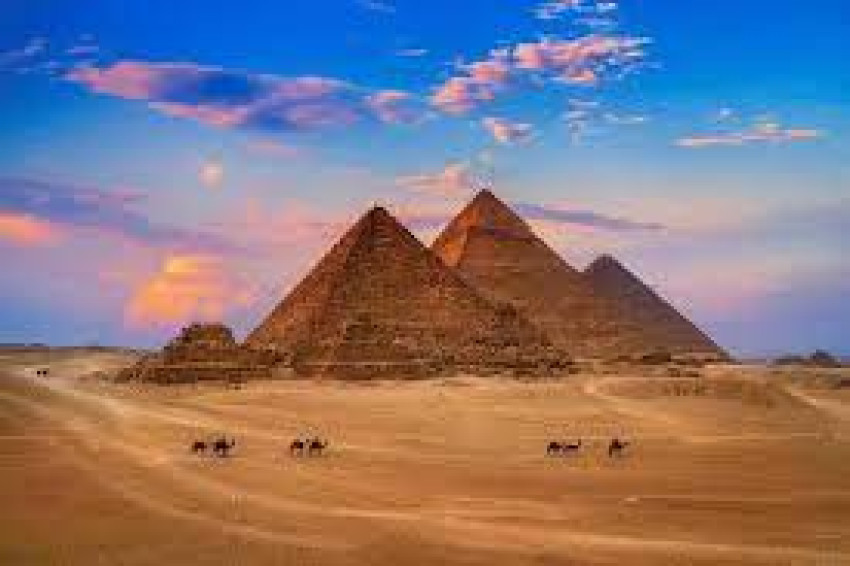
This list of world wonders was created by the Greek writer Antipater of Sidon in the 2nd century BC, based on the vision of the Greeks at that time, including only works around the Mediterranean that they considered great. modern and demonstrates human civilization
- The Giza tomb copmplex
The Giza tomb complex, built around the 26th century BC, is a complex of 3 pyramids with the height of the highest pyramid peak being 145.75 m. The Cheops Pyramid in the Giza pyramid complex, built by a Fourth Dynasty Pharaoh (named Khufu) as his tomb, mobilized more than 100,000 workers in 30 years, using more than 230,000 tablets. The stone weighs 6 tons. If we used trains to transport it today, it would take 600,000 wagons. The slope of the Pyramid's sides is about 51.5 degrees. The height of the inclined surface is 195 m. The four sides of the Pyramid look toward four directions: north, south, east and west. King Chephren's pyramid is located behind Khufu's pyramid and in front is Mycerinus' pyramid. The three smaller pyramids in the foreground were built for the three wives of King Mycerinus. These pyramids face the four cardinal directions. There is also the famous Sphinx statue carved in the image of Chephren.
The pyramids at Giza are the only world wonders still standing today. The pyramid at Giza is one of humanity's surprising achievements in history, even scientists have not yet researched the pyramid construction methods of ancient builders. In addition to the pyramid area, the ancient relics of the Giza tomb area also attract many tourists such as the Sphinx statue, Khufu boat...
- The hanging Gardens of Babylon
The Hanging Gardens of Babylon, also known as the Hanging Gardens of Semiramis, are a structure built by King Nebuchadnezzar II in 603 BC. In order to relieve the nostalgia for the homeland of the Medes of King Nebuchadnezzar II's wife, Amyitis, the tree was hung on the porch. In the hanging garden there is a fountain system consisting of two large wheels linked together by chains with wooden barrels attached. The chain and water tank also move to bring water from a tank below to the top to water the plants when the wheel rotates. To water the garden's flowers and plants, slaves had to take turns bringing water from the Euphrates River to the garden.
historians listed the Hanging Gardens as one of the wonders of the Ancient World. There are many theories about the origin of the Hanging Gardens. According to archaeologists, water was brought up from the river by a system of continuously rotating buckets from three wells, kept by a large army of people working every day to water and care for trees and fruits. Let the Hanging Garden always be green and lush. Today, the Hanging Garden is only a ruin with crumbling stone walls. Every year, visitors come to admire the remains of the foundation of the last floor of the Hanging Garden, admire the pile of stones of the collapsed wall to visualize going to the magical garden with the beautiful Queen of the land of a thousand and one nights nearly 3,000 years ago.
- The statue of Zeus
The statue of Zeus at Olympia (often called Zeus) is a wonder of the ancient world. The statue was made by the famous ancient sculptor Phidias (5th century BC) around 435 BC in Olympia, Greece. As early as the first century BC, the geographer Strabo wrote that "It seems that Zeus is about to stand up", "he will overturn the temple roof".
The statue sits the entire width of the temple hall, 12 meters (40 feet) high, placed on a 1 meter high marble base. The statue of Zeus was made from ivory (technically, the ivory was soaked in a liquid to soften it, and so could be carved and shaped as needed) and then covered with sheets of gold (hence called gilded ivory) and sat on a cedar throne inlaid with ivory, gold, and splendid gemstones engraved with the athletic games at Olympia.
Zeus's head is adorned with an olive wreath. He has a gentle face, clear pink eyes, looking straight, black eyebrows and eyelashes, coconut-shaped nose, bushy beard, thick, resolute lips, with smooth skin. made from ivory; beard, hair, robe made of gold. In his right hand, Zeus holds a small statue of Nike - the god of victory - and in his left hand is a metal scepter with an eagle perched on it, symbolizing the supreme power of the king among the gods. The god wears golden sandals and places them on a table decorated with golden lions, placed on a large chair. The top half of the statue is inlaid with ivory, pale gold that turns to a pale pink color, giving Zeus a strong vitality. The lower half of the statue's body is covered with a "cloth" made of thin gold, with animals engraved on the body, with stars and lovely flowers on the body. Visitors such as the Roman general Aemilius Paulus, who won victory over Macedonia, also had to respect the divine majesty and magnificence of the statue of the god that Phidias created.
- Artemis
Artemis is not simply a temple but also one of the few most beautiful ancient architectural works in the world remaining. The temple was built to honor the Greek goddess of the hunt. Today, the structure is located in the ancient city of Ephesus near the town of Selcuk, 50km south of Izmir city (Turkey). Construction of the temple began in 550 BC. Through a long process of construction and expansion, in 430 BC the temple was completed after 120 years. In 356 BC, the temple was destroyed by fire. Then the temple was restored on the old foundation. However, in 262, the Goths burned the temple a second time. Today, although it has been restored, Artemis Temple still only retains a part of its ancient magnificent and massive architecture.
The temple of the moon goddess Artemis, built from marble by architect Chersiphron and his son Metagenes, is 115 m long, 55 m wide, including 127 stone columns, in the city of Ephesus in present-day Turkey. To this day, only the foundation and some other parts of the second temple still exist.







